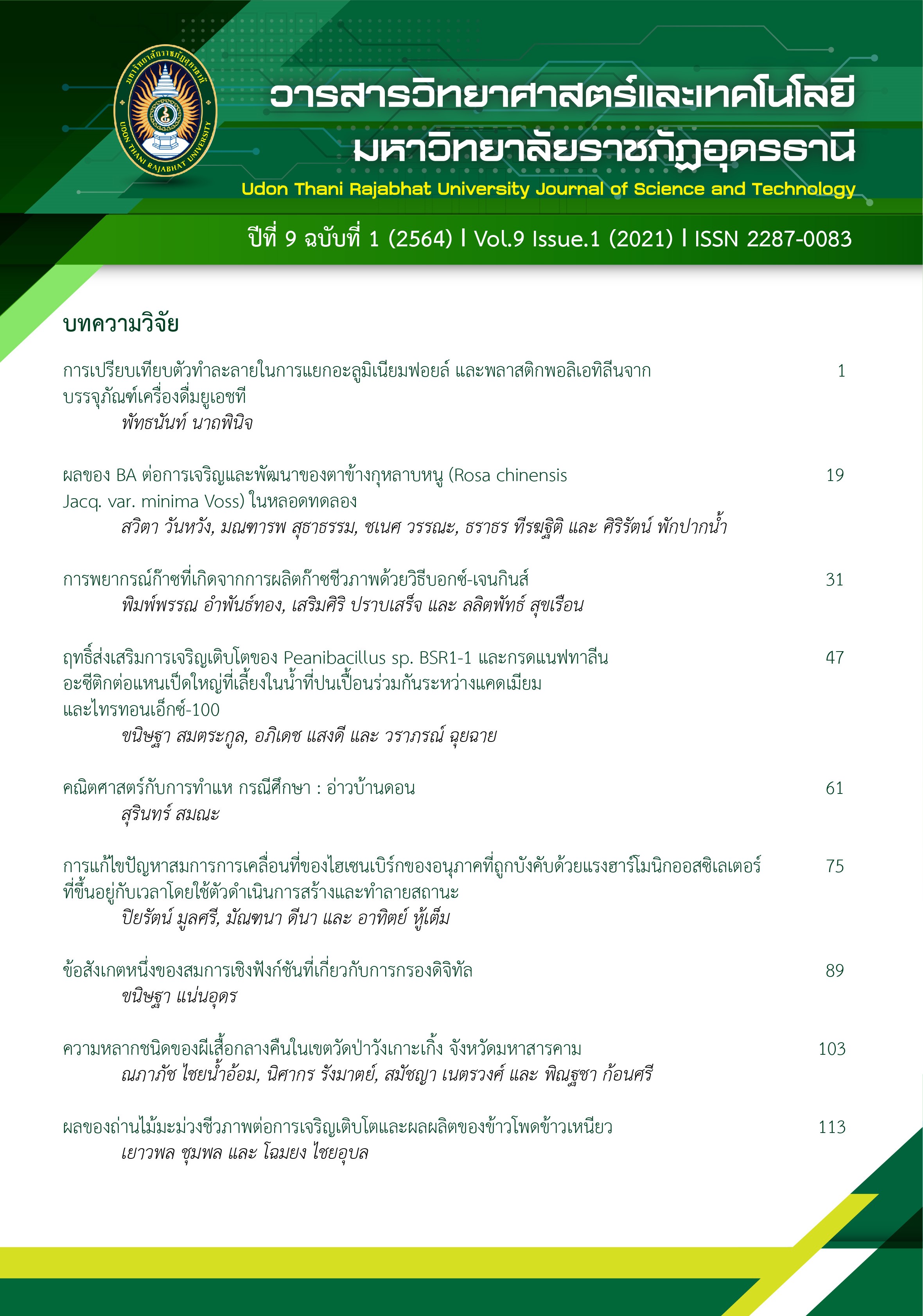ฤทธิ์ส่งเสริมการเจริญเติบโตของ Peanibacillus sp. BSR1-1 และกรดแนฟทาลีน อะซีติกต่อแหนเป็ดใหญ่ที่เลี้ยงในน้ำที่ปนเปื้อนร่วมกันระหว่างแคดเมียม และไทรทอนเอ็กซ์-100
Main Article Content
บทคัดย่อ
การศึกษานี้มีวัตถุประสงค์เพื่อประเมินผลของออกซิน 2 ชนิดคือกรดอินโดล-3-แอซิติก (Indole-3-acetic acid; IAA) ที่ผลิตโดย Peanibacillus sp. BSR1-1 และกรดแนฟทาลีน
อะซีติก (Naphthaleneacetic acid; NAA) ต่อการกระตุ้นการเจริญของแหนเป็ดใหญ่ในน้ำที่มีการปนเปื้อนร่วมกันของไทรทอนเอ็กซ์-100 และแคดเมียม ผลการศึกษาพบว่า สารควบคุมการเจริญเติบโตของพืชทั้ง 2 ชนิดคือ NAA และ น้ำเลี้ยงเซลล์ของ Peanibacillus sp. BSR1-1 ไม่สามารถเพิ่มชีวมวลและปริมาณคลอโรฟิลล์ของแหนเป็ดใหญ่ได้ เมื่อเทียบกับทรีทเมนต์ที่ไม่ได้รับสารควบคุมการเจริญเติบโต แต่เมื่อเปรียบเทียบระหว่างทรีทเมนต์ที่ได้สารควบคุมการเจริญเติบโตเท่ากัน การได้รับ NAA หรือน้ำเลี้ยงเซลล์ของ Peanibacillus sp. BSR1-1 ทำให้ ปริมาณคลอโรฟิลล์เอและคลอโรฟิลล์ทั้งหมดในทรีทเมนต์ที่มีแคดเมียม
มีแนวโน้มสูงกว่าทรีทเมนต์ที่ไม่มีแคดเมียม ดังนั้น NAA และน้ำเลี้ยงเซลล์ของ Peanibacillus sp. BSR1-1 ไม่เหมาะสมในการส่งเสริมการเจริญเติบโตของพืชในน้ำที่มีการปนเปื้อนร่วมกันระหว่างแคดเมียมกับสารลดแรงตึงผิว จึงควรใช้ออกซินสังเคราะห์ชนิดอื่น หรือการใช้หัวเชื้อ จุลินทรีย์ที่ทนต่อแคดเมียมและสร้างออกซินได้ต่อไป
Article Details
เอกสารอ้างอิง
Ahmad, F., Ahmad, I., & Khan, M. S. (2008). Screening of free-living rhizospheric bacteria for their multiple plant growth promoting activities. Microbiological Research, 163, 178-181.
Bunluesin, S., Kruatrachue, M., Pokethitiyook, P., Lanza, G. R., Upatham, E. S., & Soonthornsarathool, V. (2004). Plant screening and comparison of Ceratophyllum demersum and Hydrilla verticillata for cadmium accumulation. Bulletin of Environmental Contamination and Toxicology, 73, 591–598
Chaudhuri, D., Majumder, A., Misra, A.K., & Bandyopadhyay, K. (2014). Cadmium removal by Lemna minor and Spirodela polyrhiza. International Journal of Phytoremediation, 16(7-12), 1119-11132.
Chen, L., Luoa, S., Xiao, X., Guo, H., Chen, J., Wan, Y., Li, B., Xua, T., Xi, Q., Rao, C., Liu, C., & Zeng, G. 2010. Application of plant growth-promoting endophytes (PGPE) isolated from Solanum nigrum L. for phytoextraction of Cd-polluted soils. Applied Soil Ecology, 46, 383-389.
Chouychai, W., Saengdee, A., & Somtrakoon, K. (2020). Effect of plant growth promoting bacteria on growth of Salvinia calcullata and Spirodela polyrhiza in sodium chloride-contaminated water Phranakhon Rajabhat Research Journal (Science and Technology), 15(1), 56 – 68.
Clemens, S. (2006.) Toxic metal accumulation, responses to exposure and mechanisms of tolerance in plants. Biochimie, 88, 1707-1719.
Hou, W., Chen, X., Song, G., Wang, Q., & Chang, C. C. (2007). Effects of copper and cadmium on heavy metal polluted waterbody restoration by duckweed (Lemna minor). Plant Physiology and Biochemistry, 45, 62-69.
Huang, X. D., El-Alawi, Y., Penrose, D. M., Glick, B. R., & Greenberg, B. M. (2004). Responses of three grass species to creosote during phytoremediation. Environmental Pollution, 130, 453-463.
Huang J., Peng, L., Zeng, G., Li, X., Zhao, Y., Liu, L., Li, F., & Chai, Q. (2014). Evaluation of micellar enhanced ultrafiltration for removing methylene blue and cadmium ion simultaneously with mixed surfactants. Separation and Purification Technology, 125, 83-89.
Khan, A., Khan, S. Khan, M. A., Qamar, Z., & Waqas, M. (2015). The uptake and bioaccumulation of heavy metals by food plants, their effects on plants nutrients, and associated health risk: a review. Environmental Science and Pollution Research, 22(18), 13772-13799.
Khan, M. A., Khan, S., Khan, A., & Alam, M. (2017). Soil contamination with cadmium, consequences and remediation using organic amendments. Science of the Total Environment, 601-602, 1591-1605.
Kosolsaksakul, P., Farmer, J. G., Oliver, I. W., & Graham, M. C. (2014). Geochemical associations and availability of cadmium (Cd) in a paddy field system, northwestern Thailand. Environmental Pollution, 187, 153-161.
Ouzounidou, G., & Ilias, I. (2005). Hormone-induced protection of sunflower photosynthetic apparatus against copper toxicity. Biologia Plantarum, 49(2), 223-228.
Perera, P. A. C. T., Sundarabarathy, T. V., Sivananthawerl, T., Kodithuwakku, S. P., & Edirisinghe, U. (2016). Arsenic and cadmium contamination in water, sediments and fish is a consequence of paddy cultivation: Evidence of river pollution in Sri Lanka. Achieve Life Science, 10, 144-160.
Salazar, M. J., Rodriguez, J. H., Cid, C. V., & Pignata, M. L. (2016). Auxin effects on Pb phytoextraction from polluted soils by Tegetes minuta L. and Bidens pilosa L.: Extractive power of their root exudates. Journal of Hazardous Materials, 311, 63–69.
Seth, C. S., Chaturvedi, P. K. & Misra, V. (2007). Toxic effect of arsenate and cadmium alone and in combination on giant duckweed (Spirodela polyrrhiza L.) in response to its accumulation. Environmental Toxicology, 22(6), 539- 549.
Simmons, R. W., Pongsakul, P., Saiyasitpanich, D., & Klinhoklap, S. (2005). Elevated levels of cadmium and zinc in paddy soils and elevated levels of cadmium in rice downstream of a zinc mineralized area in Thailand: implication for public health. Environmental Geochemistry and Health, 27, 501-511.
Somtrakoon, K. & Chouychai, W. (2018). Co-phytotoxicity of ethylenediaminetetraacetic acid and synthetic surfactants on Spirodela polyrrhiza and Lemna perpusilla. RMUTP Research Journal, 12(2), 10-24.
Su, C., Jiang, Y., Li, F., Yang, Y., Lu, Q., Zhang, T., Hu, D., & Xu, Q. (2017). Investigation of subcellular distribution, physiological, and biochemical changes in Spirodela polyrhiza as a function of cadmium exposure. Environmental and Experimental Botany, 142, 24-33.
Zhu, X. F., Wang, Z. W., Dong, F., Lei, G. J., Shi, Y. Z., Li, G. X. & Zheng, S. J. (2013). Exogenous auxin alleviates cadmium toxicity in Arabidopsis thaliana by stimulating synthesis of hemicellulose 1 and increasing the cadmium fixation capacity of root cell walls. Journal of Hazardous Materials, 263, 398-403.


